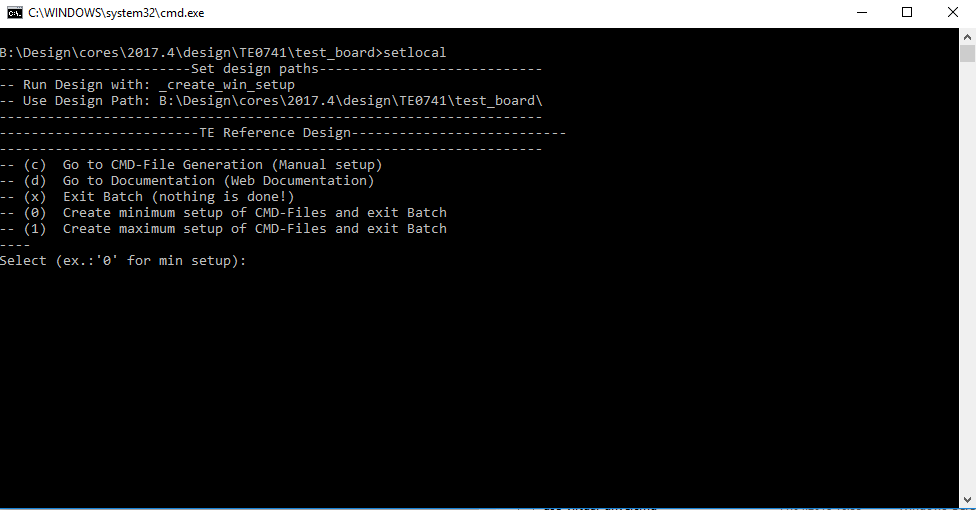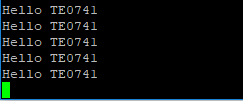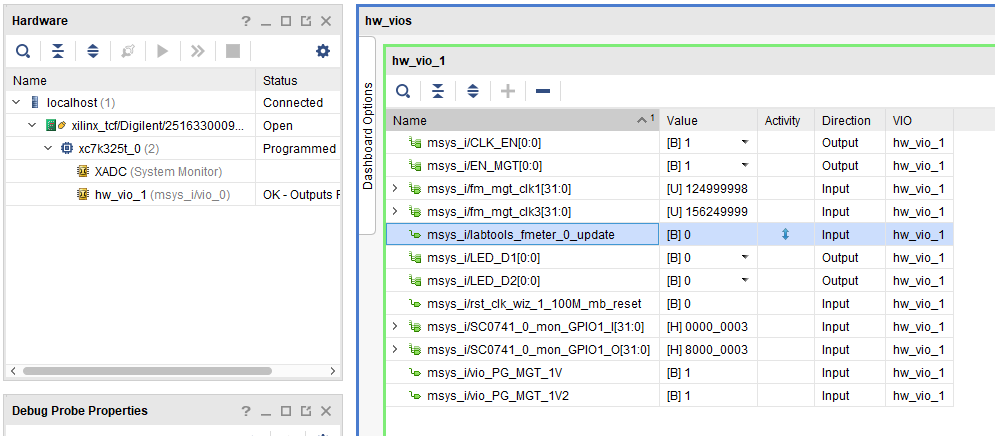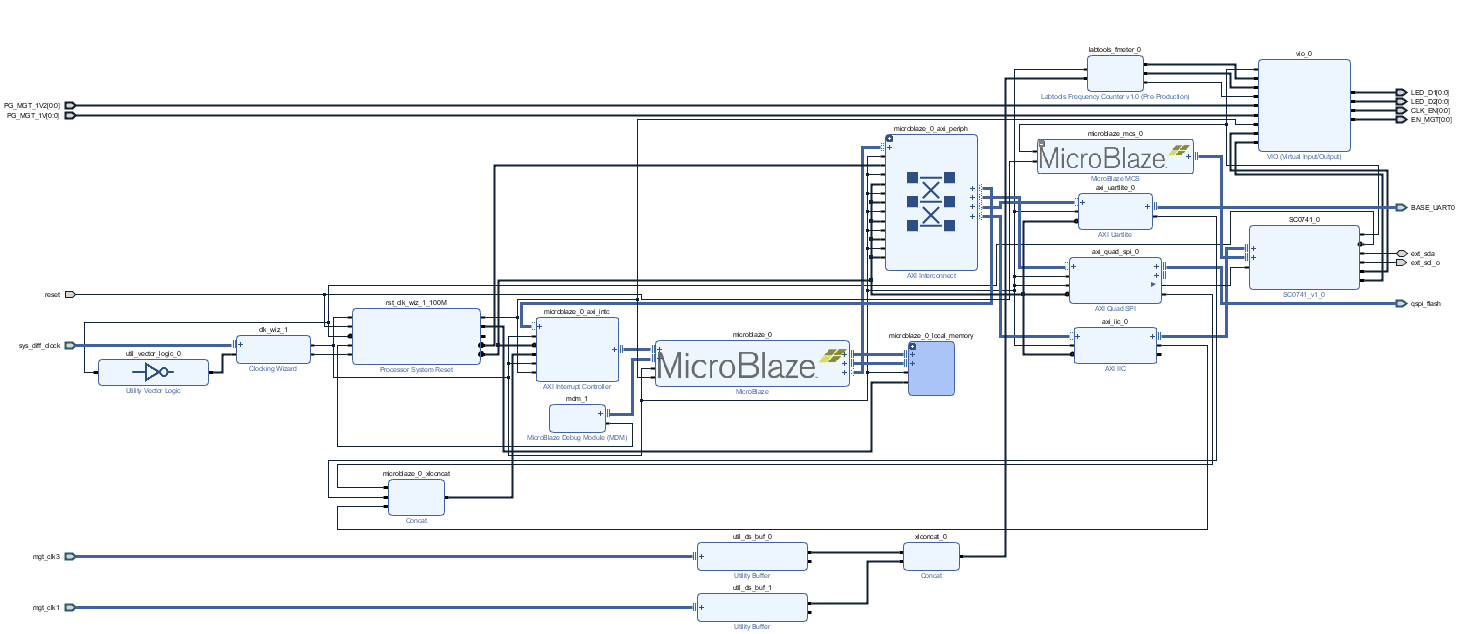<!-- Template Revision 1.0 Basic Notes - export PDF to download, if vivado revision is changed! - Template is for different design and SDSoC and examples, remove unused or wrong description! --> |
Online version of this manual and other related documents can be found at https://wiki.trenz-electronic.de/display/PD/Trenz+Electronic+Documentation |
Table of contents |
<!-- General Design description --> |
Example show, how to reconfigure SI5338 with MCS and monitor CLK. Additional MicroBlaze is add for Hello TE0741 example.
<!-- Add Basic Key Features of the design (should be tested) --> |
|
<!-- - Add changes from design - Export PDF to download, if vivado revision is changed! --> |
| Date | Vivado | Project Built | Authors | Description |
|---|---|---|---|---|
| 2018-04-16 | 2017.4 | TE0741-test_board-vivado_2017.4-build_07_20180416142156.zip TE0741-test_board_noprebuilt-vivado_2017.4-build_07_20180416142217.zip | John Hartfiel |
|
<!-- - add known Design issues and general Notes for the current revision --> |
| Issues | Description | Workaround | To be fixed version |
|---|---|---|---|
| --- | --- | --- | --- |
<!-- Add needed external Software --> |
| Software | Version | Note |
|---|---|---|
| Vivado | 2017.4 | needed |
| SDK | 2017.4 | needed |
<!-- Hardware Support --> |
Basic description of TE Board Part Files is available on TE Board Part Files.
Complete List is available on <design name>/board_files/*_board_files.csv
Design supports following modules:
| Module Model | Board Part Short Name | PCB Revision Support | DDR | QSPI Flash | Others | Notes |
|---|---|---|---|---|---|---|
| TE0741-03-070-2IF | 070_2if | REV02, REV03 | --- | 32MB | MGT LR: 6,6 Gb/s | |
| TE0741-03-160-2IF | 160_2if | REV02, REV03 | --- | 32MB | MGT LR: 6,6 Gb/s | |
| TE0741-03-325-2IF | 325_2if | REV02, REV03 | --- | 32MB | MGT LR: 6,6 Gb/s | |
| TE0741-03-410-2IF | 410_2if | REV02, REV03 | --- | 32MB | MGT LR: 6,6 Gb/s | |
| TE0741-03-070-2CF | 070_2cf | REV02, REV03 | --- | 32MB | MGT LR: 6,6 Gb/s | |
| TE0741-03-160-2CF | 160_2cf | REV02, REV03 | --- | 32MB | MGT LR: 6,6 Gb/s | |
| TE0741-03-325-2CF | 325_2cf | REV02, REV03 | --- | 32MB | MGT LR: 6,6 Gb/s | |
| TE0741-03-410-2CF | 410_2cf | REV02, REV03 | --- | 32MB | MGT LR: 6,6 Gb/s | |
| TE0741-03-160-2C1 | 160_2c1 | REV02, REV03 | --- | 32MB | MGT LR: 10,3125 Gb/s |
Design supports following carriers:
| Carrier Model | Notes |
|---|---|
| TE0701 | |
| TE0703 | used as reference carrier |
| TE0705 | |
| TE0706 | |
| TEBA0841 |
Additional HW Requirements:
| Additional Hardware | Notes |
|---|---|
| USB Cable for JTAG/UART | Check Carrier Board and Programmer for correct type |
| XMOD Programmer | Carrier Board dependent, only if carrier has no own FTDI |
<!-- Remove unused content --> |
For general structure and of the reference design, see Project Delivery
| Type | Location | Notes |
|---|---|---|
| Vivado | <design name>/block_design <design name>/constraints <design name>/ip_lib <design name>/firmware | Vivado Project will be generated by TE Scripts |
| SDK/HSI | <design name>/sw_lib | Additional Software Template for SDK/HSI and apps_list.csv with settings for HSI |
| PetaLinux | <design name>/os/petalinux | PetaLinux template with current configuration |
| Type | Location | Notes |
|---|---|---|
| SI5338 Project | \misc\SI5338 |
<!-- <table width="100%"> <tr> <th>File </th> <th>File-Extension</th> <th>Description </th> </tr> <tr> <td>BIF-File </td> <td>*.bif </td> <td>File with description to generate Bin-File </td> </tr> <tr> <td>BIN-File </td> <td>*.bin </td> <td>Flash Configuration File with Boot-Image (Zynq-FPGAs) </td> </tr> <tr> <td>BIT-File </td> <td>*.bit </td> <td>FPGA Configuration File </td> </tr> <tr> <td>DebugProbes-File </td> <td>*.ltx </td> <td>Definition File for Vivado/Vivado Labtools Debugging Interface </td> </tr> <tr> <td>Debian SD-Image </td> <td>*.img </td> <td>Debian Image for SD-Card </td> </tr> <tr> <td>Diverse Reports </td> <td> --- </td> <td>Report files in different formats </td> </tr> <tr> <td>Hardware-Platform-Specification-Files</td> <td>*.hdf </td> <td>Exported Vivado Hardware Specification for SDK/HSI </td> </tr> <tr> <td>LabTools Project-File </td> <td>*.lpr </td> <td>Vivado Labtools Project File </td> </tr> <tr> <td>MCS-File </td> <td>*.mcs </td> <td>Flash Configuration File with Boot-Image (MicroBlaze or FPGA part only) </td> </tr> <tr> <td>MMI-File </td> <td>*.mmi </td> <td>File with BRAM-Location to generate MCS or BIT-File with *.elf content (MicroBlaze only) </td> </tr> <tr> <td>OS-Image </td> <td>*.ub </td> <td>Image with Linux Kernel (On Petalinux optional with Devicetree and RAM-Disk) </td> </tr> <tr> <td>Software-Application-File </td> <td>*.elf </td> <td>Software Application for Zynq or MicroBlaze Processor Systems </td> </tr> <tr> <td>SREC-File </td> <td>*.srec </td> <td>Converted Software Application for MicroBlaze Processor Systems </td> </tr> </table> --> |
File | File-Extension | Description |
|---|---|---|
| BIT-File | *.bit | FPGA (PL Part) Configuration File |
| DebugProbes-File | *.ltx | Definition File for Vivado/Vivado Labtools Debugging Interface |
| Diverse Reports | --- | Report files in different formats |
| Hardware-Platform-Specification-Files | *.hdf | Exported Vivado Hardware Specification for SDK/HSI and PetaLinux |
| LabTools Project-File | *.lpr | Vivado Labtools Project File |
MCS-File | *.mcs | Flash Configuration File with Boot-Image (MicroBlaze or FPGA part only) |
MMI-File | *.mmi | File with BRAM-Location to generate MCS or BIT-File with *.elf content (MicroBlaze only) |
| Software-Application-File | *.elf | Software Application for Zynq or MicroBlaze Processor Systems |
Reference Design is only usable with the specified Vivado/SDK/PetaLinux/SDx version. Do never use different Versions of Xilinx Software for the same Project.
<!-- Add correct path:https://shop.trenz-electronic.de/en/Download/?path=Trenz_Electronic/TE0803/Reference_Design/2017.1/Starterkit --> |
Reference Design is available on:
<!-- Basic Design Steps Add/ Remove project specific --> |
Reference Design is available with and without prebuilt files. It's recommended to use TE prebuilt files for first lunch. |
Trenz Electronic provides a tcl based built environment based on Xilinx Design Flow.
See also:Vivado/SDK/SDSoC
The Trenz Electronic FPGA Reference Designs are TCL-script based project. Command files for execution will be generated with "_create_win_setup.cmd" on Windows OS and "_create_linux_setup.sh" on Linux OS.
TE Scripts are only needed to generate the vivado project, all other additional steps are optional and can also executed by Xilinx Vivado/SDK GUI. For currently Scripts limitations on Win and Linux OS see: Project Delivery Currently limitations of functionality

<!-- Description of Block Design, Constrains... BD Pictures from Export... --> |
Check Module and Carrier TRMs for proper HW configuration before you try any design. |
Xilinx documentation for programming and debugging: Vivado/SDK/SDSoC-Xilinx Software Programming and Debugging
Not used on this Example.
Open Serial Console (e.g. putty)


<!-- Description of Block Design, Constrains... BD Pictures from Export... --> |

set_property BITSTREAM.GENERAL.COMPRESS TRUE [current_design] set_property BITSTREAM.CONFIG.CONFIGRATE 66 [current_design] set_property CONFIG_VOLTAGE 3.3 [current_design] set_property CFGBVS VCCO [current_design] set_property CONFIG_MODE SPIx4 [current_design] set_property BITSTREAM.CONFIG.SPI_32BIT_ADDR YES [current_design] set_property BITSTREAM.CONFIG.SPI_BUSWIDTH 4 [current_design] set_property BITSTREAM.CONFIG.M1PIN PULLNONE [current_design] set_property BITSTREAM.CONFIG.M2PIN PULLNONE [current_design] set_property BITSTREAM.CONFIG.M0PIN PULLNONE [current_design] set_property BITSTREAM.CONFIG.USR_ACCESS TIMESTAMP [current_design] |
#LED
set_property PACKAGE_PIN D26 [get_ports {LED_D1[0]}]
set_property IOSTANDARD LVCMOS33 [get_ports {LED_D1[0]}]
set_property PACKAGE_PIN E26 [get_ports {LED_D2[0]}]
set_property IOSTANDARD LVCMOS33 [get_ports {LED_D2[0]}]
#MGT Power
set_property PACKAGE_PIN G25 [get_ports {PG_MGT_1V2[0]}]
set_property IOSTANDARD LVCMOS33 [get_ports {PG_MGT_1V2[0]}]
set_property PACKAGE_PIN K23 [get_ports {PG_MGT_1V[0]}]
set_property IOSTANDARD LVCMOS33 [get_ports {PG_MGT_1V[0]}]
set_property PACKAGE_PIN H22 [get_ports {EN_MGT[0]}]
set_property IOSTANDARD LVCMOS33 [get_ports {EN_MGT[0]}]
#SI5338 CLK
set_property PACKAGE_PIN C26 [get_ports {CLK_EN[0]}]
set_property IOSTANDARD LVCMOS33 [get_ports {CLK_EN[0]}]
#I2C PLL SI5338
set_property PACKAGE_PIN A20 [get_ports ext_scl_o]
set_property IOSTANDARD LVCMOS33 [get_ports ext_scl_o]
set_property PACKAGE_PIN B21 [get_ports ext_sda]
set_property IOSTANDARD LVCMOS33 [get_ports ext_sda] |
#Fmeter can be ignored, it's only simple measurement
set_false_path -from [get_pins {msys_i/labtools_fmeter_0/U0/FMETER_gen[*].COUNTER_F_inst/bl.DSP48E_2/CLK}] -to [get_pins {msys_i/labtools_fmeter_0/U0/F_reg[*]/D}]
set_false_path -from [get_pins msys_i/labtools_fmeter_0/U0/toggle_reg/C] -to [get_pins {msys_i/labtools_fmeter_0/U0/FMETER_gen[*].COUNTER_F_inst/bl.DSP48E_2/RSTC}]
set_false_path -from [get_pins msys_i/labtools_fmeter_0/U0/toggle_reg/C] -to [get_pins {msys_i/labtools_fmeter_0/U0/FMETER_gen[*].COUNTER_F_inst/bl.DSP48E_2/RSTA}]
set_false_path -from [get_pins msys_i/labtools_fmeter_0/U0/toggle_reg/C] -to [get_pins {msys_i/labtools_fmeter_0/U0/FMETER_gen[*].COUNTER_F_inst/bl.DSP48E_2/RSTB}]
set_false_path -from [get_pins msys_i/labtools_fmeter_0/U0/toggle_reg/C] -to [get_pins {msys_i/labtools_fmeter_0/U0/FMETER_gen[*].COUNTER_F_inst/bl.DSP48E_2/CEALUMODE}]
set_false_path -from [get_pins msys_i/labtools_fmeter_0/U0/toggle_reg/C] -to [get_pins {msys_i/labtools_fmeter_0/U0/FMETER_gen[*].COUNTER_F_inst/bl.DSP48E_2/RSTCTRL}]
set_false_path -from [get_clocks -of_objects [get_pins msys_i/clk_wiz_1/inst/mmcm_adv_inst/CLKOUT0]] -to [get_clocks {msys_i/util_ds_buf_0/U0/IBUF_OUT[0]}]
set_false_path -from [get_clocks -of_objects [get_pins msys_i/clk_wiz_1/inst/mmcm_adv_inst/CLKOUT0]] -to [get_clocks {msys_i/util_ds_buf_1/U0/IBUF_OUT[0]}]
|
<!-- optional chapter separate sections for different apps --> |
For SDK project creation, follow instructions from:
MCS Firmware to configure SI5338 and Reset System.
Template location: \sw_lib\sw_apps\scu
Xilinx Hello World example as andless loop
Template location: \sw_lib\sw_apps\hello_te0741
<!-- Add Description for other Software, for example SI CLK Builder ... --> |
Download ClockBuilder Desktop for SI5338
To get content of older revision got to "Change History" of this page and select older document revision number.
<!-- Generate new entry: 1:add new row below first 2:Copy Page Information Macro(date+user) Preview, Page Information Macro Preview 3.Update Metadate =Page Information Macro Preview+1 --> |
| Date | Document Revision | Authors | Description |
|---|---|---|---|
| |||
| 2018-04-16 | v.1 |
| |
| All |